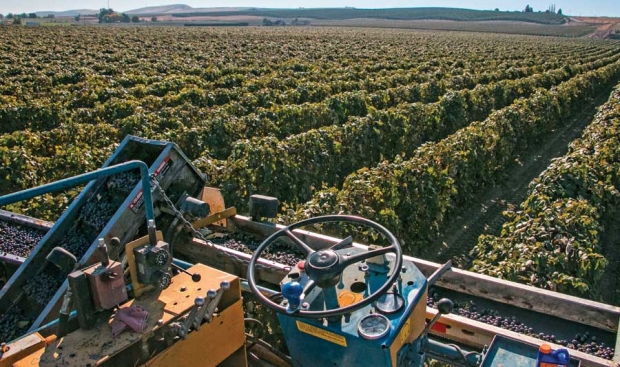
Concord grape harvest in Outlook, Washington on October 10, 2014. (TJ Mullinax/Good Fruit Grower)
Wild grapevines want to grow into big plants, and they’ll produce a lot of fruit if left to their own devices, particularly on clusters on the outsides of the canopy.
Juice grape growers are advised to take advantage of this natural propensity of big vines.
Canopy management is much more complicated for wine grapes, but for juice grapes in Washington, managing vineyards with pruning, irrigation and maybe some thinning can help to control the size of the vines and help boost berry size and cluster numbers, said Dr. Markus Keller, Washington State University viticulturist.
Ideally, growers want balanced vines, an ideal microclimate with an open, productive canopy, high yield and high quality, low pressure from pests, and easy vineyard access for mechanization, Keller said. Proper vineyard management techniques help to determine some of those things, he said.
“It’s a little like starting with a full bank account. At the very beginning of the growing season, you’re starting with the yield potential, because you’ve already pruned your vines, and the pruning level determines how many fruitful shoots you’ll have on the vines,” Keller told growers at the Washington State Grape Society meeting in November. “From then on, it’s all down. You can no longer add yield potential, you can only reduce it.”
Pruning determines bud number and position, while irrigation determines canopy size and yield. Crop thinning determines a grower’s final yield and maturity, particularly from one season to another. Berry weight is much less important to yield than are cluster and berry numbers.
“We know that the number of berries is mostly determined by the flower number, which is determined inside the bud in the previous growing season and during budbreak of the current season,” he said. “So, maximizing bud numbers has the greater potential to modify the crop than anything done to the canopy during the current growing season.”
Growers should machine prune to maximum bud number and only thin when absolutely necessary, Keller said. At growers’ current rates of return on their crops, that thinning should largely be done by machine. “You cannot hand prune and expect to maximize yield potential year after year.”
Machine prune and minimally prune, he said. Growers should not prune anything off the top of the canopy, where the fruitful canes are located, but lightly prune the sides of the canopy to manage vine size.
They should skirt the bottom of the canopy as high as necessary to contain the fruit, so that the mechanical harvester can pick all of the fruit.
Thin the crop only under extreme circumstances — in a cool season when the fruit may fail to ripen without thinning, or in a very hot season with a very heavy crop, Keller said. However, “in all other cases, I’d advise against thinning and maximize your crop potential.”
Thinning at fruit set does not affect the timing of veraison, Keller said, but it can accelerate ripening after veraison has started. It appears to have no effect on cold hardiness.
Water ties to canopy
Overall, juice grapes carry big canopies that require between 2 feet and 2.5 feet of water per year, which comes in both rainfall and irrigation.
They also drink frequently, though water needs vary during the season. Vines consume 5 to 10 percent of their water from bud break to fruit set, but they demand 30 to 60 percent of their water from fruit set to veraison — when it’s hottest, Keller said.
“There can be no growth without water. Cell expansion requires water,” he said. “Water determines canopy and berry size — more water equals bigger canopies and bigger berries.”
Shoot growth and yield are maximized at 3 to 4 percent below the field capacity of the soil, so growers should learn the field capacity of their vineyards.
Ripening berries are very powerful at attracting water, even on a plant that is wilting, Keller said. That means that irrigation management is much more important during the early part of the season than it is during ripening in the later part of the season.
As the season progresses, water demand falls to just 10 to 30 percent from veraison to harvest and from 5 to 25 percent from harvest to leaf fall. Growers should refill the top 3 feet of soil for freeze and start-up insurance for the following season. •
– by Shannon Dininny






Leave A Comment